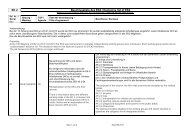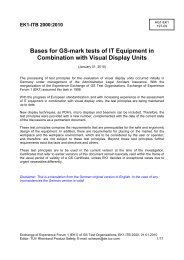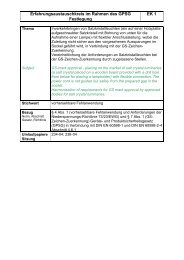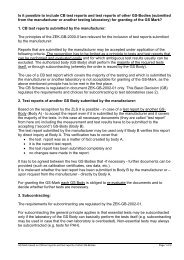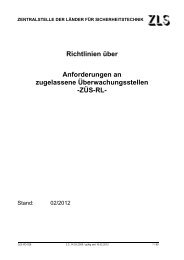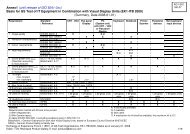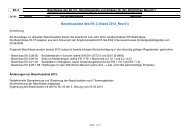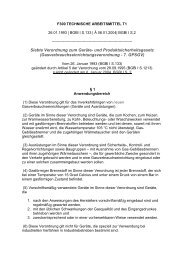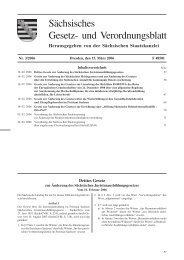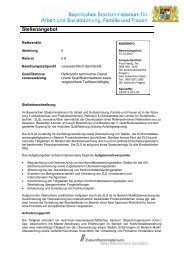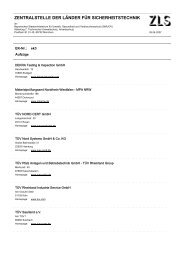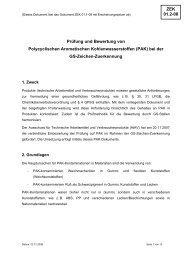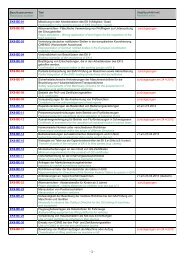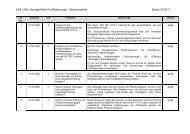EK1-ITB 2000:2009 - ZLS
EK1-ITB 2000:2009 - ZLS
EK1-ITB 2000:2009 - ZLS
- No tags were found...
Create successful ePaper yourself
Turn your PDF publications into a flip-book with our unique Google optimized e-Paper software.
<strong>EK1</strong>-<strong>ITB</strong> <strong>2000</strong>:<strong>2009</strong>AG1-<strong>EK1</strong>176-08 rev 1Bases for GS-mark tests of IT Equipment inCombination with Visual Display Units(Status as of January 01, <strong>2009</strong>)The processing of test principles for the evaluation of visual display units occurred initially inGermany under management of the Administrative Legal Accident Insurance. With thereorganization of the Experience Exchange of GS Test Organizations, Exchange of ExperienceForum 1 (<strong>EK1</strong>) assumed this task in 1998.With the progress of European standardization, and with increasing experience in the assessmentof IT equipment in combination with visual display units, the test principles are being maintainedup to date.New display techniques, as PDA's, micro displays and beamers can be included. Therefore, thetest principles were provided with a new number, complemented with the date of the current stateof the discussions as a permanent document.These test principles comprise the requirements that are prerequisites for the safe and ergonomicdesign of the equipment. In addition, there are requirements for the workplace and the workplaceenvironment, which are to be considered by the user or operator, and therefore, are not subject tothese test principles.These test principles are to be used in the current version at the time of the investigation.Certificates that refer to earlier versions of this document remain basically valid within the frame ofthe usual period of validity of a GS Certificate, unless <strong>EK1</strong> decides in exceptional cases due tourgent necessities differently.Disclaimer: This is a translation from the German original version to English. In the case of anyinconsistencies the German version is valid!Exchange of Experience Forum 1 (<strong>EK1</strong>) of GS Test Organizations, <strong>EK1</strong>-<strong>ITB</strong> <strong>2000</strong>,Status as of January 01, <strong>2009</strong>, rev. 1Editor: TÜV Rheinland Product Safety; E-mail: scheuer@de.tuv.com 1/17
<strong>EK1</strong>-<strong>ITB</strong> <strong>2000</strong>:<strong>2009</strong>A.1 General PrinciplesA.1.1 Guidelines and Laws2006/95/ECDirective 2006/95/EC of the European Parliament and of the Council of 12December 2006 on the harmonisation of the laws of Member States relating toelectrical equipment designed for use within certain voltage limits (codified version).89/336/EECCouncil Directive of 3 May 1989 on the approximation of the laws of the MemberStates relating to electromagnetic compatibility, implemented in Germany by theElectromagnetic Compatibility of Equipment Act.(replaced by 2004/108/EC)2004/108/ECDirective of the European Parliament and of the Council of 15 December 2004 onthe approximation of the laws of the Member States relating to electromagneticcompatibility and repealing Directive 89/336/EEC.90/270/EECCouncil Directive of 29 May 1990 on the minimum requirements concerning thesafety and health protection during work on visual display units (Individual Directivein the context of Article 16, Clause 1 of Directive 89/391/EEC), implemented inGermany by the Ordinance on Visual Display Units (Occupational Safety Law, 19.December 1998 version).93/68/EECCouncil Directive of 22 July 1993 on the amendment of the above-mentionedDirectives.98/37/ECCouncil Directive of 22 June 1998 on the approximation of the laws of the MemberStates relating to machinery, implemented in Germany by the ninth ordinance tothe Technical Plant and Equipment Act.2001/95/ECDirective of the European Parliament and of the Council of 3. December 2001 ongeneral product safety.German Product Safety & liability law (GPSG)dated January 6, 2004 including therein named changes of ordinances of theoverrulled GSG (Product Safety Law).Exchange of Experience Forum 1 (<strong>EK1</strong>) of GS Test Organizations, <strong>EK1</strong>-<strong>ITB</strong> <strong>2000</strong>,Status as of January 01, <strong>2009</strong>, rev. 1Editor: TÜV Rheinland Product Safety; E-mail: scheuer@de.tuv.com 2/17
<strong>EK1</strong>-<strong>ITB</strong> <strong>2000</strong>:<strong>2009</strong>Electromagnetic Compatibility of Equipment Act (EMVG), 18. September 1998version.(not in force)Electromagnetic Compatibility of Equipment Act (EMVG), 26.02.2008.Ordinance on occupational safety and health protection during work with visualdisplays (Bildschirmarbeitsverordnung - BildscharbV), 04. December 1996version.Ordinance on the protection against injury by X-ray radiation (X-ray Ordinance -RöV), 08 January 1987 version.R&TTE directive 1999/5/ECDirective on radio equipment and telecommunications terminal equipment and themutual recognition of their conformityA.1.2 Test and Evaluation ConsiderationsThe manufacturer defines the intended context of use of the equipment. Ifnecessary, he has to determine any special environmental conditions in theInstructions for Use. These declarations are to be considered during the test andare to be repeated in the certificate. In particular, restrictive declarations of themanufacturer in his product description must also be documented in the certificate.Information necessary for installation, startup procedure and safe use mustaccompany the product in writing (German language). Broader information may becontained on data storage devices (CD, floppy disk).The existing test principles are binding on all GS test- and certification bodies andare to be considered by market surveillance authorities in Germany too.If the requirements of the applicable standards are not specific, the EssentialRequirements of the Directives or the protection objectives of the Standards are tobe interpreted by the experts accordingly.Exchange of Experience Forum 1 (<strong>EK1</strong>) of GS Test Organizations, <strong>EK1</strong>-<strong>ITB</strong> <strong>2000</strong>,Status as of January 01, <strong>2009</strong>, rev. 1Editor: TÜV Rheinland Product Safety; E-mail: scheuer@de.tuv.com 3/17
<strong>EK1</strong>-<strong>ITB</strong> <strong>2000</strong>:<strong>2009</strong>A.2 Standards for Product SafetyA.2.1Basic StandardDIN EN 60950-1DIN EN 60065Safety of information technology equipmentAudio, visual and similar electronic apparatus - SafetyrequirementsAdditionally, the following standards may be applicable:A.2.2Safety in GeneralA.2.3DIN EN ISO12100-1DIN EN ISO12100-2Electrical SafetySafety of machinery; basic concepts, general principlesfor design; part 1: basic terminology, methodologySafety of machinery - Basic concepts, general principlesfor design - Part 2: Technical principles andspecificationsDIN EN 60204 - 1 Safety of machinery - Electrical equipment of machines -Part 1: General requirementsA.2.4Mechanical SafetyDIN EN 294DIN EN 349DIN EN 547 - 1DIN EN 547 - 2Safety of machinery; safety distances to prevent dangerzones from being reached by the upper limbsSafety of machinery; minimum gaps to avoid crushing ofparts of the human bodySafety of machinery - Human body measurements - Part1: Principles for determining the dimensions required foropenings for whole body access into machinerySafety of machinery - Human body measurements - Part2: Principles for determining the dimensions required foraccess openingsDIN EN 61310 part 1 Safety of machinery - Indication, marking and actuation -Part 1: Requirements for visual, auditory and tactilesignalsDIN EN 61310 part 2 Safety of machinery - Indication, marking and actuation -Part 2: Requirements for markingExchange of Experience Forum 1 (<strong>EK1</strong>) of GS Test Organizations, <strong>EK1</strong>-<strong>ITB</strong> <strong>2000</strong>,Status as of January 01, <strong>2009</strong>, rev. 1Editor: TÜV Rheinland Product Safety; E-mail: scheuer@de.tuv.com 4/17
<strong>EK1</strong>-<strong>ITB</strong> <strong>2000</strong>:<strong>2009</strong>A.2.5Safety concerning high temperatureDIN EN 563CEN guide 12Safety of machinery - Temperatures of touchablesurfaces - Ergonomics data to establish temperature limitvalues for hot surfaces (includes Corrigendum AC:1994and Amendment A1:1999)Temperatures of surfaces likely to be touchedReplaced byCENELEC Guide 29Temperatures of hot surfaces likely to be touchedA.2.6Safety concerning noiseDIN EN ISO 7779DIN EN 29295ISO 9296Acoustics; measurement of airborne noise emitted byinformation technology and telecommunicationsequipmentAcoustics; measurement of high-frequency noise emittedby computer and business equipment (ISO 9295:1989);German version EN 29295:1991Acoustics; declared noise emission values of computerand business equipmentA.2.7Labelling and Information in Instructions for UseISO/IEC 12119ISO/IEC Guide 37DIN EN 62079Information technology - Software packages – Qualityrequirements and testingInstructions for use of products of consumer interestPreparation of instructions Structuring, content andpresentationA.2.8Ergonomic designFor testing of the ergonomic design of a product in particular apply:DIN 2137 Part 1DIN 2137 Part 2Text and office systems - Keyboards - Part 1: Germankeyboard for typewriters; key arrangement and allocationof characters to keysText and office systems - Keyboards - Part 2: Germankeyboard for data and text processing; key arrangementand allocation of graphic characters to keysDIN 2137 Part 6Text and office systems - Keyboards - Part 6: Germankeyboard for data and text processing as well as fortypewriters; key arrangement and allocation of functionsto keysExchange of Experience Forum 1 (<strong>EK1</strong>) of GS Test Organizations, <strong>EK1</strong>-<strong>ITB</strong> <strong>2000</strong>,Status as of January 01, <strong>2009</strong>, rev. 1Editor: TÜV Rheinland Product Safety; E-mail: scheuer@de.tuv.com 5/17
<strong>EK1</strong>-<strong>ITB</strong> <strong>2000</strong>:<strong>2009</strong>DIN 2137 Part 6,Annex 1DIN 2137 Part 10DIN 2137 Part 11DIN 2137 Part 12Annex 1 to DIN 2137DIN EN ISO 9241-1DIN EN 29241 - 2DIN EN 29241 - 3DIN EN ISO 9241-4DIN EN ISO 9241-6Text and office systems - Keyboards - Part 6: Germankeyboard for data and text processing as well as fortypewriters; information on the symbols to be used torepresent functionsText and office systems - Keyboards - Part 10: Germankeyboard for data and text processing as well as fortypewriters; arrangement of key positions and keydistancesText and office systems - Keyboards - Part 11: Germankeyboard for data and text processing as well as fortypewriters; principles governing the allocation of graphiccharacters or of functions to keys and the placement oftheir symbols on the keysText and office systems - Keyboards - Part 12: Germankeyboard for data and text processing; key arrangementand allocation for portable computersText and office systems - Keyboards - German keyboarddata and text processing as well as for typewriters;information on graphic keys and the allocation of graphiccharacters or symbolsErgonomic requirements for office work with visualdisplay terminals (VDTs) - Part 1: General introduction(ISO 9241-1:1997); German version EN ISO 9241-1:1997Ergonomic requirements for office work with visualdisplay terminals (VDTs); part 2: guidance on taskrequirementsErgonomic requirements for office work with visualdisplay terminals (VDTs); part 3: visual displayrequirements(replaced by ISO 9241-3xx in 2008)Ergonomic requirements for office work with visualdisplay terminals (VDTs) - Part 4: Keyboard requirementsfor visual display terminals (ISO 9241-4:1998); Germanversion EN ISO 9241-4:1998Ergonomic requirements for office work with visualdisplay terminals (VDTs) - Part 6: Guidance on the workenvironmentExchange of Experience Forum 1 (<strong>EK1</strong>) of GS Test Organizations, <strong>EK1</strong>-<strong>ITB</strong> <strong>2000</strong>,Status as of January 01, <strong>2009</strong>, rev. 1Editor: TÜV Rheinland Product Safety; E-mail: scheuer@de.tuv.com 6/17
<strong>EK1</strong>-<strong>ITB</strong> <strong>2000</strong>:<strong>2009</strong>DIN EN ISO 9241-7DIN EN ISO 9241-8DIN EN ISO 9241-9DIN EN 60068-2-70DIN EN ISO 13406-2DIN EN ISO 9241-3xx(xx means 00-07)ISO/IEC 9995-1ISO/IEC 9995-2ISO/IEC 9995-3ISO/IEC 9995-4ISO/IEC 9995-5ISO/IEC 9995-6Ergonomic requirements for office work with visualdisplay terminals (VDTs) - Part 7: Requirements fordisplay with reflections (ISO 9241-7:1998); Germanversion EN ISO 9241-7:1998(replaced by ISO 9241-3xx in 2008)Ergonomic requirements for office work with visualdisplay terminals (VDTs) - Part 8: Requirements fordisplayed colours (ISO 9241-8:1997); German versionEN ISO 9241-8:1997(replaced by ISO 9241-3xx in 2008)(Draft standard) DIN EN ISO 9241-9, Publicationdate:1998-10 Ergonomic requirements for office workwith visual display terminals (VDTs) - Part 9:Requirements for non-keyboard input devices (ISO/DIS9241-9:1998); German version EN ISO 9241-9:1998Environmental testing - Part 2: Tests - Test Xb: Abrasionof marking and letterings caused by rubbing of fingersand handsErgonomic requirements for work with visual displaysbased on flat panels – Part 2: Ergonomic requirementsfor flat panel displays(replaced by ISO 9241-3xx in 2008)Ergonomic requirements for visual displays(replaces ISO 9241 -3,-7,-8, ISO 13406 in 2008)Information technology - Keyboard layouts for text andoffice systems - Part 1: General principles governingkeyboard layoutsInformation technology - Keyboard layouts for text andoffice systems - Part 2: Alphanumeric sectionInformation technology - Keyboard layouts for text andoffice systems - Part 3: Complementary layouts of thealphanumeric zone of the alphanumeric sectionInformation technology - Keyboard layouts for text andoffice systems - Part 4: Numeric sectionInformation technology - Keyboard layouts for text andoffice systems - Part 5: Editing sectionInformation technology - Keyboard layouts for text andoffice systems - Part 6: Function sectionExchange of Experience Forum 1 (<strong>EK1</strong>) of GS Test Organizations, <strong>EK1</strong>-<strong>ITB</strong> <strong>2000</strong>,Status as of January 01, <strong>2009</strong>, rev. 1Editor: TÜV Rheinland Product Safety; E-mail: scheuer@de.tuv.com 7/17
<strong>EK1</strong>-<strong>ITB</strong> <strong>2000</strong>:<strong>2009</strong>ISO/IEC 9995-7ISO/IEC 9995-8ISO TR 24784Information technology - Keyboard layouts for text andoffice systems - Part 7: Symbols used to representfunctionsInformation technology - Keyboard layouts for text andoffice systems - Part 8: Allocation of letters to the keys ofa numeric keypadInformation technology -- Keyboard layouts foralphanumeric inputs -- Description of ISO/IEC 9995issues regarding users' needs and necessary innovationsExchange of Experience Forum 1 (<strong>EK1</strong>) of GS Test Organizations, <strong>EK1</strong>-<strong>ITB</strong> <strong>2000</strong>,Status as of January 01, <strong>2009</strong>, rev. 1Editor: TÜV Rheinland Product Safety; E-mail: scheuer@de.tuv.com 8/17
<strong>EK1</strong>-<strong>ITB</strong> <strong>2000</strong>:<strong>2009</strong>A2.9 Further decisions from meetings of the Exchange of Experience Forum 1(<strong>EK1</strong>) and its Working Group AG1A.2.9.1A.2.9.2A.2.9.3A.2.9.4A.2.9.5A.2.9.6A.2.9.7A.2.9.8A.2.9.9A.2.9.10Keyboards (1 st meeting AG1 <strong>EK1</strong>):If the key board does not comply with the above mentioned standards, decisionsmust be made for special groups of users.Keyboard caps, labelling of the front side (4 th meeting AG1 <strong>EK1</strong>):In principle the same requirements apply as for labelling of the topside.Notebooks, keyboard height (4 th meeting AG1 <strong>EK1</strong>):Cancelled - 12 th meeting AG1 <strong>EK1</strong>Gloss of keyboard and housing (4 th meeting AG1 <strong>EK1</strong>):The evaluation of the contrast and the gloss of keyboards and housings are to bemade with consideration of the manufacturer's specification for the intended use.If no other life cycle is indicated by the manufacturer or specifications are made bystandards, the values on key caps are to be judged after 5 million cycles.Specification for antireflection coating of monitors (4 th meeting AG1 <strong>EK1</strong>):Monitor class or targeted application is to be indicated on the certificate.Specification for noise in certificates (5 th meeting AG1 <strong>EK1</strong>):For the orientation of the operator the emitted sound pressure level and soundpower level are to be indicated on the certificate for operation in standby and fullperformance mode, according to DIN EN ISO 7779 and DIN EN ISO 29295.Keying feedback (5 th and 6 th meeting AG1 <strong>EK1</strong>):Actuation of a key shall be accompanied by a feedback. The feedback can bekinaesthetic (key displacement with snap function) or not kinaesthetically (keydisplacement with ramp function) accompanied by an auditory feedback. Theauditory feedback can take place in terms of hardware solution (e.g. by aloudspeaker integrated in the keyboard) or by software solutions (e.g. as part ofthe operating system). The today generally used kinaesthetic feedback issufficient, not however an end-impact noise.Segmented keyboards (4 th meeting <strong>EK1</strong>):Cancelled – replaced by A.2.9.13Video graphic boards (3 rd meeting <strong>EK1</strong>):Video graphic boards are not qualified for a GS-Mark.Keyboards, abrasion test (7 th meeting AG1 <strong>EK1</strong>):The abrasion test with synthetic sweat in its present form is confirmed. Testingwith diluted (thin) Oil of Olaz can be accepted only, when the proof is produced,that the results are equivalent.Exchange of Experience Forum 1 (<strong>EK1</strong>) of GS Test Organizations, <strong>EK1</strong>-<strong>ITB</strong> <strong>2000</strong>,Status as of January 01, <strong>2009</strong>, rev. 1Editor: TÜV Rheinland Product Safety; E-mail: scheuer@de.tuv.com 9/17
<strong>EK1</strong>-<strong>ITB</strong> <strong>2000</strong>:<strong>2009</strong>A.2.9.11A.2.9.12A.2.9.13A.2.9.14A.2.9.15A.2.9.16Keyboards, DIN 60068-2-70 (7 th meeting AG1 <strong>EK1</strong>):Applicable for testing are DIN EN ISO 9241 part 4 in combination with DIN 60068-2-70 (in that order). The abrasion test shall be performed with the force of 1,5 N +20% as defined in DIN EN ISO 9241 part 4 for an applied force for keydisplacement and not with the values given by DIN EN 60068-2-70.Keyboards, laser inscription (7 th meeting AG1 <strong>EK1</strong>):The durability of legends with laser inscription has to be proofed with the testprocedures as intended in DIN EN ISO 9241 part 4. If a test confirms that thedurability of legends for a specific, qualified laser inscription procedure and clearlyspecified materials is given, specific tests could be skipped.Segmented keyboards (8 th meeting AG1 <strong>EK1</strong>):All participants agree, due to insufficient definition of test requirements, not toaccept test orders for such keyboards. Segmented keyboards with adjustableangle have to be tested in normal position according to ISO 9241-4 and DIN 2137.Character size on visual displays (8 Th meeting AG1 <strong>EK1</strong>):Due to some inconsistency in ISO 9241-3, the test is conducted with a charactersize of 20 min. of arc. Equivalent test pattern with horizontal or vertical lines maybe used if not otherwise specified by the manufacturer. An example for a 17” CRTis given in annex 2.Keyboard layout, Notebook keyboards (9 th + 12 th meeting AG1 <strong>EK1</strong>):The layout must be suitable for the intended user group. The tests are performedin accordance with DIN 2137-12.Deviations from test basisIn case of deviations from test basis <strong>EK1</strong>-<strong>ITB</strong> <strong>2000</strong> the following procedure apply:1. Preparation of an test report. The test report shows the deviation from the testbasis.2. Proof of necessity of the deviation.3. Presentation of the results within the Exchange of Experience Forum 1 (EK 1)Alternative test method for keyboards (addition):4. Performing of an user test concerning the acceptance of deviations by aqualified laboratory according to ISO 9241-4 and ISO 9241-115. Presentation of the results within the Exchange of Experience Forum 1 (EK 1)A.2.9.17 DIN EN ISO 13406-2DIN EN ISO 13406-2 will be added within <strong>EK1</strong>-<strong>ITB</strong> <strong>2000</strong> (additional row within thetable). DIN EN ISO 13406-2 is applicable since 01.01.2003. Already existingcertificates, based on previous test procedure (ISO 9241) expire on December 31,2004.(no longer considered)A.2.9.18Evaluation of gloss within the direct field of viewCompany logos are not considered during gloss measurements.Exchange of Experience Forum 1 (<strong>EK1</strong>) of GS Test Organizations, <strong>EK1</strong>-<strong>ITB</strong> <strong>2000</strong>,Status as of January 01, <strong>2009</strong>, rev. 1Editor: TÜV Rheinland Product Safety; E-mail: scheuer@de.tuv.com 10/17
<strong>EK1</strong>-<strong>ITB</strong> <strong>2000</strong>:<strong>2009</strong>A.2.9.19A.2.9.20A.2.9.21A.2.9.22A.2.9.23GS test with restricted scopeFor GS tests of IT equipment used within a restricted scope (like home area,entertainment, toys etc.) the test has to follow the test principles <strong>EK1</strong>-<strong>ITB</strong> <strong>2000</strong>.Deviations and their necessity shall be reported within the test report.DIN EN ISO 13406-2 testingGS certificates shall indicate the following information from May 1, 2003 on:- Pixel fault class- Class reflection (for positive/negative polarity)- CLass viewing contrast- Class viewing chromaticity uniformity(decision changed due to the release of ISO 9241-307; data according toAnnex 6 have to be implemented)GS mark for Pocket PC’s (11 th meeting AG1 <strong>EK1</strong>):The requirements for pocket PC’s have to be applied from October 1, 2003. Theprocedure is described in document <strong>EK1</strong>/70-02, which is incorporated in theannex.(ISO 9241-307 has to be applied)Plasma Displays, LCD/TFT-TV’s (11 th meeting AG1 <strong>EK1</strong>):If the manufacturer does not explicit exclude the work at visual display workplaces these test principles have to be applied to Plasma Displays and LCD/TFT-TV’s.(ISO 9241-307 has to be applied)Graphic boards (11 th meeting AG1 <strong>EK1</strong>):If a graphic board offers a analogue as well as digital output, the analogue outputhas to be evaluated due to expectation of higher quality at the digital output. Usethis procedure unless otherwise specified by the manufacturer.If a graphic board use different chip sets every version of the chip sets has to beevaluated.A.2.9.24Classic typewriters (11 th meeting AG1 <strong>EK1</strong>):DIN 2137 part 1 as well as all parts belonging to DIN 2137 have to be applied forelectronic typewriters.Exchange of Experience Forum 1 (<strong>EK1</strong>) of GS Test Organizations, <strong>EK1</strong>-<strong>ITB</strong> <strong>2000</strong>,Status as of January 01, <strong>2009</strong>, rev. 1Editor: TÜV Rheinland Product Safety; E-mail: scheuer@de.tuv.com 11/17
<strong>EK1</strong>-<strong>ITB</strong> <strong>2000</strong>:<strong>2009</strong>A.2.9.25Gloss of housing for a server (12 th meeting AG1 <strong>EK1</strong>):The test of the gloss of housing for a server follows annex 1. Here the followingcriteria are used:Set-up Location of theserver*)Decision criteriaGS test accordingtoWithin a server room Without graphic board EN 60950 + noiseWith graphic board<strong>EK1</strong>-<strong>ITB</strong> <strong>2000</strong> incl.Gloss of housingWithin a server room With graphic board. The manufacturerdeclares that the set-up of the server ismade in the server room only and shall notbe in the field of vision of the user **)<strong>EK1</strong>-<strong>ITB</strong> <strong>2000</strong>withoutmeasurement ofthe gloss ofhousing*) Server = computer for data processing with or withoutgraphic board for use in server rooms**) Scope: Declaration of the manufacturer given in thebrochure and in the User’s Manual:The product is not suitable for use at visual displayworkplaces according to §2 of the German Ordinance forWork with Visual Display Units.Statements on the GS certificate:♦ Test specification♦ Hint that the tested product is not suitable for use atvisual display workplaces.A.2.9.26Pocket PC’s having a size larger than DIN A5 (12 th meeting AG1 <strong>EK1</strong>):For Pocket PC’s having a size up to DIN A4 the corresponding test principleshave to be applied. Therefore “sub-notebooks” are included as well.The minimum character size of 2,6 mm for key legends is applicable to charactersonly. Symbols like +, -, ; are excluded.A.2.9.27A.2.9.28User’s Manual (12 th meeting AG1 <strong>EK1</strong>):Safety relevant instructions of the User’s Manual have to be delivered in paperformat. It is not sufficient to store these instructions on a hard disk or a CD-ROM.Keyboard (13 th meeting AG1 <strong>EK1</strong>):A reduction of the number of key activities from 5 Mio. to 4 Mio is possible, if after4 Mio. key activities a minimum contrast of 3,3:1 will be achieved. If the contrastratio is lower the test has to be continued until 5 Mio. activities.repealed (17. meeting AG1 <strong>EK1</strong> decision A.2.9.33)Exchange of Experience Forum 1 (<strong>EK1</strong>) of GS Test Organizations, <strong>EK1</strong>-<strong>ITB</strong> <strong>2000</strong>,Status as of January 01, <strong>2009</strong>, rev. 1Editor: TÜV Rheinland Product Safety; E-mail: scheuer@de.tuv.com 12/17
<strong>EK1</strong>-<strong>ITB</strong> <strong>2000</strong>:<strong>2009</strong>A.2.9.29A.2.9.30A.2.9.31Flat panel displays (13 th meeting AG1 <strong>EK1</strong>):The requirement of the inclination in front of the screen has not to be applied forflat panel displays.Data to be supplied in GS certificates (14 th meeting AG1 <strong>EK1</strong>):For clear and uniform presentation of information a minimum data are required inGS certificates for IT products (see appendix 6).Gloss of housing of peripheral devices (15 th / 22 meeting AG1 <strong>EK1</strong>):The requirements for the gloss of housing apply to peripheral devices used at thevisual display workplace according to BildscharbV. Peripheral devices intendedfor use outside the visual display workplace can receive a GS-Mark if the scope isindicated in the User’s Manual as well as the certificate.That means the following wording is possible in situations where the use withinthe field of view is not intended and where sufficient hints are given in the User’sManual for the avoidance of such situations to ensure that display work is notaffected.Wording in the certificate: “This device is not intended for use in the direct field ofview at visual display workplaces. To avoid incommoding reflexions at visualdisplay workplaces this device must not be placed in the direct field of view.”Note:(direct) field of view see ISO 8995, ISO 11064-4, EN 842, DIN 5340Exchange of Experience Forum 1 (<strong>EK1</strong>) of GS Test Organizations, <strong>EK1</strong>-<strong>ITB</strong> <strong>2000</strong>,Status as of January 01, <strong>2009</strong>, rev. 1Editor: TÜV Rheinland Product Safety; E-mail: scheuer@de.tuv.com 13/17
<strong>EK1</strong>-<strong>ITB</strong> <strong>2000</strong>:<strong>2009</strong>A.2.9.33Keyboard (17 th meeting AG1 <strong>EK1</strong>)A reduction of the key strokes for keyboards made of PBT material with laserinscription processes from 5 million to 2 million is possible if, after 2 million strokesa minimum contrast of 3,3:1 is achieved and the gloss level is under 20 glossunits.A reduction of the key strokes for keyboards with laser inscription processes from5 million to 4 million is possible if, after 4 million strokes a minimum contrast of3,3:1 is achieved and the gloss level is under 20 gloss units.The resolution A.2.9.28 is herewith nullified.Note: The gloss level of key caps can be determined alternatively with gloss levelplates (maximum matt or semi matt). (Hint: gloss templates/gloss level plates areavailable from Institut für Lackprüfung, Felsweg 19, 35435, Wettenberg,Germany).Exchange of Experience Forum 1 (<strong>EK1</strong>) of GS Test Organizations, <strong>EK1</strong>-<strong>ITB</strong> <strong>2000</strong>,Status as of January 01, <strong>2009</strong>, rev. 1Editor: TÜV Rheinland Product Safety; E-mail: scheuer@de.tuv.com 15/17
<strong>EK1</strong>-<strong>ITB</strong> <strong>2000</strong>:<strong>2009</strong>A.2.9.34Application of DIN EN 50332-1/-2 (18 th and 19 th meeting AG1 <strong>EK1</strong>)The requirements of EN 50332 for limitations of the sound pressure level of ear-/headphone outputs is expanded to include stationary products with ear-/headphone outputs because they are subject to the same dangers regardinghearing damage/hearing loss. The following items have to be considered:1. Measurement procedureUse a) or b):a) Electric test (IT device without supplied ear-/headphone)In deviation to EN 50332 a measurement of the output voltage with adjustment ofthe volume control to center position has to be made with and without equalizer.During the measurements the equalizer is adjusted to its neutral or center position(factory setting). In case the reading is ≤ 150 mV the instructions for use mustconsider a warning note to fulfill the requirements according to <strong>EK1</strong>-<strong>ITB</strong> <strong>2000</strong>. Incase the reading is > 150 mV the requirements according to <strong>EK1</strong>-<strong>ITB</strong> <strong>2000</strong> arenot fulfilled.b) Acoustic test (IT device with supplied ear-/headphone)In case of a system (IT device with an ear-/headphone) the type of the ear-/headphone (manufacturer and model/type) has to be specified in the instructionsfor use. The requirements according to EN 50332-1 have to be fulfilled. Indeviation to EN 50332-1 the measurements shall be conducted with adjustment ofthe volume control to center position with and without equalizer. The instructionsfor use must contain a warning note.Informative: A measurement of the output voltage with adjustment of the volumecontrol and equalizer to maximum has to be carried out.2. Warning note (example)Excessive sound pressure from ear-/headphones can cause hearing damage/hearing loss.Adjustment of the volume control as well as the equalizer to other settings thanthe center position may increase the ear-/headphones output voltage andtherefore the sound pressure level.The use of factors influencing the ear-/headphones output other than thosespecified by the manufacturer (e.g. operating system, equalizer software,firmware, driver) may increase the ear-/headphones output voltage and thereforethe sound pressure level.The use of ear-/headphones other than those specified by the manufacturer maylead to heightened sound pressure level.Exchange of Experience Forum 1 (<strong>EK1</strong>) of GS Test Organizations, <strong>EK1</strong>-<strong>ITB</strong> <strong>2000</strong>,Status as of January 01, <strong>2009</strong>, rev. 1Editor: TÜV Rheinland Product Safety; E-mail: scheuer@de.tuv.com 16/17
<strong>EK1</strong>-<strong>ITB</strong> <strong>2000</strong>:<strong>2009</strong>A.2.9.35The requirements for electronic scales with LCD indicators for the use in weighingwork stations are to adhere to Annex 7.Note: Products limited to one indicator line only are exempted.A.2.9.36Input devices; keyboards (20 meeting AG1 Ek1)ISO TR 24784 is introduced into the testing principles in addition to DIN 2137 andISO 9995.A.3 Contents of the Test documentation• product description• intended context of use• Test report according to EN 45001 / DIN ISO/IEC 17025• Specifications for sound emission values according to Annex 1Annex 1Tabular compilation of the ergonomic bases for the GS testing of IT devices in cobination withvisual display units.(changes have to be considered with release of ISO 9241-3xx)Annex 2Test procedure for character heightAnnex 3Cancelled - 12 th meeting AG1 <strong>EK1</strong>Annex 4Requirements for flat panels for the GS-mark (Interpretation of DIN EN ISO 13406-2)(changes have to be considered with release of ISO 9241-3xx)Annex 5Requirements for Pocket PC’s(changes have to be considered with release of ISO 9241-3xx)Annex 6: Specifications in a GS Certificate(changes have to be considered with release of ISO 9241-3xx)Annex 7: Annex 7: Requirements for electronic scales(changes have to be considered with release of ISO 9241-3xx)Exchange of Experience Forum 1 (<strong>EK1</strong>) of GS Test Organizations, <strong>EK1</strong>-<strong>ITB</strong> <strong>2000</strong>,Status as of January 01, <strong>2009</strong>, rev. 1Editor: TÜV Rheinland Product Safety; E-mail: scheuer@de.tuv.com 17/17
Annex 1 (don’t use the following table with release of ISO 9241-3xx)Basis for GS Test of IT Equipment in Combination with Visual Display Units (<strong>EK1</strong>-<strong>ITB</strong> <strong>2000</strong>)(Summary, Date <strong>2009</strong>-01-01)AG1-<strong>EK1</strong>176-08 rev 1RequirementStandard/ ReferenceCRT - VDUFlat panelDisplayPC(System unit)with CRT – VDUor Flat panelDisplayKeyboard Notebook PrinterScanner1 Image quality DIN EN 29241-3 X X orDIN EN ISO 13406-2 X X X2 Reflection characteristics DIN EN ISO 9241-7 XDIN EN ISO 13406-2 X X3 Colour requirements DIN EN ISO 9241-8 X X orDIN EN ISO 13406-2 X X X4 Input requirements DIN EN ISO 9241-4 X X 3)DIN 2137 X 2) X 2)5 Sound power level L WAd(Operation accordingto manufacturer)6 Sound pressure level L pAm(Operation accordingto manufacturer)7 Tilt anglemax. forward:min. backward:PeripheraldevicesNon-keyboardinput devicesDIN EN ISO 9241-9 X XISO 7779 (ISO 9296) X 1) X 1) X 1) X 1) X 1) X 1) X 1) X 1)BildscharbV, A 17.ISO 7779 (ISO 9296)BildscharbV, A 17.BildscharbV, A 5.X 1) X 1) X 1) X 1) X 1) X 1) X 1) X 1)5°≥ 5° ≥ 5°≥ 5°8 Swivel (rotation) BildscharbV, A 5. max. ± 180° max. ± 180°9 Max. force to swivel BildscharbV, A 5. max. 100 N max. 100 N10 Brightness adjustable BildscharbV, A 3. X X X11 Contrast adjustable BildscharbV, A 3. X X 4) X 4)12 Gloss of housing BildscharbV, A 8., A 15. ≤ 20 glossunits≤ 20 glossunits≤ 20 gloss units ≤ 20 glossunits≤ 20 glossunits≤ 20 glossunits≤ 20 glossunits13 Headphone output EN 50332 X 5) X 5) X 5) X 5) X 5) X 5)14 Technical documentation GPSG X X X X X X X X15 User’s manual GPSG X X X X X X X XRemark:4) If technically provided.Requirements marked with X have to be proved.5) if available1) With integrated fan. 6) (Not used)2) With German layout. 7) A mechanism for tilt shall be available, the maximum tilt is 15°.3) Apply DIN EN ISO 9241-4 excluding exeptions given in DIN 2137-12.BildscharbV = German Ordinance for work with Visual Display Units, based on European Council Directive 90/270/EECGPSG = German Product Safety & liability lawExchange of Experience Forum 1 (<strong>EK1</strong>) of GS Test Organizations, <strong>EK1</strong>-<strong>ITB</strong> <strong>2000</strong>, Status as of January 01, <strong>2009</strong>, rev. 1Editor: TÜV Rheinland Product Safety; E-mail: scheuer@de.tuv.com, Note: In case of any inconsistencies the German original version is valid! 1/20X 7)≤ 20 gloss units
6. Guideline for the GS testRequirement Classes obligatory for GS mark7.1 Design viewing≥400mm500 mmdistance(touch screens)≥300 mm7.2 Design viewing I,II,III,IV Table 45direction7.3 Design screenilluminationemissive displays 250-750 lx Screen tilt angle 10°250 lx + 250 lx cos αtransflective andMinimum illuminance Minimum illuminancereflective displaysDefined by the Defined by the manufacturermanufacturer7.5 Chromaticity I,II,III,IV IV Table 45uniformity difference7.6 Character height ≥16 ´ 20´ - only for fix fonts7.7 Stroke width 8% till 20% 8% till 20% - only for fix fonts7.8 Character width to0,5:1 till 1:1 0,5:1 till 1:1 - only for fix fontsheight ratio7.9 Fill factor ≥0,3 ≥0,37.10 Character format ≥ 5x7 ≥ 7x9 - only for fix fonts7.11 Betweencharacter≥ 1 pixel≥ 1 pixel - only for fix fontsspacing7.12 Between- word≥ 1 pixel≥ 1 pixel - only for fix fontsspacing7.13 Between-line≥ 1 pixel≥ 1 pixel - only for fix fontsspacing7.14 Display I,II,III,IV III Table 45luminance7.15 Contrast I,II,III,IV III Table 457.17 Reflectionsclass reflection I,II,III I,II or III see <strong>EK1</strong>-<strong>ITB</strong> <strong>2000</strong> and <strong>EK1</strong>decision A.2.9.57.17.1 Contrast in the I,II,III,IV I,II,III,IV see <strong>EK1</strong>-<strong>ITB</strong> <strong>2000</strong> and <strong>EK1</strong>presence ofdecision A.2.9.5reflections7.17.2 Contrast of un- I,II,III,IV I,II,III,IV see <strong>EK1</strong>-<strong>ITB</strong> <strong>2000</strong> and <strong>EK1</strong>wanted reflections7.18 Image polarity If the screen isintended for use innegative and positivepolarity, use bothpolarities during thetests.decision A.2.9.5If the screen is intended for use innegative and positive polarity, useboth polarities during the tests.Exchange of Experience Forum 1 (<strong>EK1</strong>) of GS Test Organizations, <strong>EK1</strong>-<strong>ITB</strong> <strong>2000</strong>,Status as of January 01, <strong>2009</strong>, rev. 1Editor: TÜV Rheinland Product Safety; E-mail: scheuer@de.tuv.com,Note: In case of any inconsistencies the German original version is valid! 5/20
Requirement Classes obligatory for GS mark7.19 Luminance I,II,III,IV IV Table 45uniformity7.20 Pixel faults I,II,III,IV I,II,III,IV I or II according to Table 37.21 Image formationtimemanufacturers specification withintable 1t≤10 ms10
Annex 4.2 (with release of ISO 9241-3xx)Ergonomic Requirements for flat panels for GS-mark(Interpretation of DIN EN ISO 9241-3xx)Determination of the intended context of use according to ISO 9241-307, (example)Element Attribut QuantificationUser Vision User with normal or to normal corrected vision of any age, 7 years or older(any literate user).EnvironmentTaskDesign screen illuminance, E STypical components of theillumination: Large aperture source(15°) and small aperture source(1°) illuminationIlluminantAmbient temperatureContent and perceptionAmount of informationImage typeDesign viewing distance, D design,viewDesign viewing direction, Θ D , Φ DDesign viewing direction range(angle of inclination and azimuth)Eye and head positionNumber of usersVertical 250 lx + 250 lx × cos(α) in offices, where α is the screen tilt angle.The screen tilt angle is considered to be 75°.1. L REF,EXT = 200 cd/m 2 and L REF,SML = 2 000 cd/m 2 (suitable forgeneral office use);2. L REF,EXT = 200 cd/m 2 or L REF,SML = 2 000 cd/m 2 (suitable for most,but not all, office environments);3. L REF,EXT = 125 cd/m 2 or L REF,SML = 200 cd/m 2 (requires a speciallycontrolled luminous environment).Dabei ist:L REF,EXT is the luminance of the large aperture source (15°) andL REF,SML is the luminance of the small aperture source (1°).CIE illuminant D65ambient temperature of approximate 15°C to 35°C is considered.Artificial informationPreferred screen size for sufficient amount of information with appropriateobject size and resolution.Still image, quasi-static or moving image is considered, if not otherwisespecified by the supplier.500 mmWithin a specific range of angles from the normal.Viewing cone with a single visual displayThe maximum inclination angle range Θ range is:Θ range = 2 × arctan(D active /2 × D design,view ). WhereD active is the diagonal of the active display area andD design,view is the design viewing distance.The design inclination angle is within 0° ≤ Θ D ≤ 40° – Θ range /2. The azimuthangle Φ is 0° bis 360°.NOTE This definition correspond to viewing direction range classClass viewing III of earlier ISO 13406-2.From fixed to moving.Typical single or multiple.Usage Display handling For this compliance route stationary display handling is considered, if nototherwise specified by the supplier.Exchange of Experience Forum 1 (<strong>EK1</strong>) of GS Test Organizations, <strong>EK1</strong>-<strong>ITB</strong> <strong>2000</strong>,Status as of January 01, <strong>2009</strong>, rev. 1Editor: TÜV Rheinland Product Safety; E-mail: scheuer@de.tuv.com,Note: In case of any inconsistencies the German original version is valid! 7/20
Annex 5:Ergonomic Requirements for Pocket-PC‘s (AG1 of <strong>EK1</strong>, 70-02)1. Definition: Pocket-PCPC with integrated Display, which is smaller than DIN A4 (12 th meeting AG1 <strong>EK1</strong>) and whichincludes an alphanumeric keyboard and/or a pen for data input and which is not used forsteady work of visual display tasks.2. Use of Pocket-PCIn general Pocket-PC’s are hold by hand or standy-situated on a table.3. Requirements according <strong>EK1</strong>-<strong>ITB</strong> <strong>2000</strong> and remarksdon’t use the following table with release of ISO 9241-3xxRequirements Standards /references Pocket-PC1 Image Quality ISO 13406-2 see a)2 reflection characteristics ISO 13406-2 see a)3 Color characteristics ISO 13406-2 see a)4 Input requirements DIN EN ISO 9241-4DIN 2137see b)5 Sound power level LWAd(operation accordingmanufacturer)6 Schalldruckpegel LpA(Betrieb laut Hersteller)7 tilt anglemax. forward:min. backward:DIN EN ISO 9241-9ISO 7779 (ISO 9296)BildscharbV, A 17.ISO 7779 (ISO 9296)BildscharbV, A 17.BildscharbV, A 5.see c)N/A8 Swivel rotation BildscharbV, A 5. N/A9 force to swivel BildscharbV, A 5. N/A10 brightness adjustable BildscharbV, A 3. X (as far as foreseen)11 contrast adjustable BildscharbV, A 3. X (as far as foreseen)12 gloss of housing (reflections) BildscharbV, A 8.,A 15.13 technical documentation GSG X14 User’s manual GSG X see d)With X marked requirements basically have to be fulfilled.N/AN/A≤ 20 Gloss unitsExchange of Experience Forum 1 (<strong>EK1</strong>) of GS Test Organizations, <strong>EK1</strong>-<strong>ITB</strong> <strong>2000</strong>,Status as of January 01, <strong>2009</strong>, rev. 1Editor: TÜV Rheinland Product Safety; E-mail: scheuer@de.tuv.com,Note: In case of any inconsistencies the German original version is valid! 8/20
don’t use the following table 3 a) with release of ISO 9241-3xxa) Display and information presentation (ISO 13406-2):Clause DIN EN Applicability/LimitationISO 13406-27.1 Design viewing distanceViewing distance min. 300mm at pocket PC’s held by handViewing distance min. 500mm at pocket PC’s lying on table7.2 Design viewing directionTaking into account a viewing direction of up to 20° (max. 40°).7.3 Design screen illuminanceSpecification of minimum and maximum ambient illumination bymanufacturer7.4 Gaze and head-tilt anglesN/A7.5 Chromaticity uniformity differenceminimum Viewing direction class IV7.6 Character heightCharacter height minimum 20-22 minutes of arc7.7 Stroke widthApply7.8 Character width-to-height ratioApply7.9 Fill factorApply7.10 Character formatApply7.11 Between-character spacingApply7.12 Between-word spacingApply7.13 Between-line spacingApply7.14 Display luminanceIllumination according actual presented research resultsWith integrated illumination: minimum 3cd/m² .7.15 ContrastContrast according actual presented research results−0,65−0,65CRmin= 2,2 • (1 + 2,2 • LL) = 2,2 + 4,84 • LL7.16 Luminance balanceN/A7.17 ReflectionsSmall sized specular reflections (1°) are not to be considered as they canbe eliminated by typical use. Only diffuse and specular big sizedreflections (15°) have to be considered.7.18 Image polarityApply7.19 Luminance uniformityMinimum Viewing direction class IV7.20 Pixel faultsApplyExchange of Experience Forum 1 (<strong>EK1</strong>) of GS Test Organizations, <strong>EK1</strong>-<strong>ITB</strong> <strong>2000</strong>,Status as of January 01, <strong>2009</strong>, rev. 1Editor: TÜV Rheinland Product Safety; E-mail: scheuer@de.tuv.com,Note: In case of any inconsistencies the German original version is valid! 9/20
7.21 Image formation timeApply7.22 Absolute luminance codingN/A7.23 Blink codingN/A7.24 Temporal instability (flicker)Apply: Flickermeasurement can also be performed for grey-scale7.25 Default colour setApply7.26 Multicolour object sizeN/A7.27 Colour differencesAnwenden7.28 Spectrally extreme coloursN/A7.29 Number of coloursN/Ab) Keyboard of Pocket-PC‘s (ISO 9241-4, ISO/IEC 9995):Clause Applicability/LimitationISO 9241-46.1.1 Palm-restsN/A6.1.2 Sections of the keyboardN/A6.1.3 Home row heightN/A6.1.4 Slope of the keyboardApply6.1.5 Profile of keyboardAnwenden6.1.6 Keyboard surfaces and material properties of keyboardsApply6.1.7 Keyboard placementN/A6.1.8 Keyboard slope adjustment mechanismN/A6.2.1 Key layout and center-line spacingN/A6.2.2 Keytop designMinimum 64mm²6.2.3 Key displacement and forceAnwenden6.2.4.1 GeneralApply6.2.4.2 Kinaesthetic feedbackN/AExchange of Experience Forum 1 (<strong>EK1</strong>) of GS Test Organizations, <strong>EK1</strong>-<strong>ITB</strong> <strong>2000</strong>,Status as of January 01, <strong>2009</strong>, rev. 1Editor: TÜV Rheinland Product Safety; E-mail: scheuer@de.tuv.com,Note: In case of any inconsistencies the German original version is valid! 10/20
6.2.4.3 Auditory feedbackN/A6.2.4.4 Visual feedbackApply6.2.5 Rebound action (bounce)Apply6.2.6 Key roll-overApply6.2.7 Key repeat functionApply (Software)6.2.8.1 Graphical symbolsN/A6.2.8.2 Geometric design of key legendsApply6.2.8.3 Number and positioning of legendsN/A6.2.8.4 Durability of legendsApply6.2.9 Cursor keys and keys in the editing sectionApply modified6.2.10 Numeric keypadApply if applicable6.2.11 Keytop shapeApplyExchange of Experience Forum 1 (<strong>EK1</strong>) of GS Test Organizations, <strong>EK1</strong>-<strong>ITB</strong> <strong>2000</strong>,Status as of January 01, <strong>2009</strong>, rev. 1Editor: TÜV Rheinland Product Safety; E-mail: scheuer@de.tuv.com,Note: In case of any inconsistencies the German original version is valid! 11/20
ISO/IEC 9995Clause Applicability/LimitationISO 9995-17.4 Key location numbering requirementsAnwendbar8.1 Group positionsErsten Absatz nicht anwendenZweiten Absatz anwenden8.2 Level positions within one groupAnwendbar, wenn die drei Ebenen in einer Spalte dargestellt werdenClause Applicability/LimitationISO 9995-27 Arrangement and location of keys in the alphanumeric zone of thealphanumeric sectionN/A8 Functions of the alphanumeric zone of the alphanumeric sectionApplicableClause Applicability/LimitationISO 9995-35 Common secondary group layoutApplicable6 Complementary Latin group layoutApplicableClause Applicability/LimitationISO 9995-45-10 Apply if presentClause Applicability/LimitationISO 9995-55-12 Apply grouping of Cursor keys only as „Cross“ or „Inverte T“ LayoutApplicability/LimitationClauseISO 9995-65-6 ApplyClause Applicability/LimitationISO 9995-75 Descriptions of functionsNot to apply as used keys are not commonly usedClause Applicability/LimitationISO 9995-85-6 Apply if presentc) Pen (ISO 9241-9):Requiremnets according ISO 9241-9:<strong>2000</strong> Clause 6.2.6.1 (Grasp surface), 6.2.6.5 (Size)und 6.2.6.6 (Weight) shall be fulfilled.d) Remark in the Users Manual and certificate„not for permanent video display work“„nicht für stänige Bildschirmarbeit geeignet“Exchange of Experience Forum 1 (<strong>EK1</strong>) of GS Test Organizations, <strong>EK1</strong>-<strong>ITB</strong> <strong>2000</strong>,Status as of January 01, <strong>2009</strong>, rev. 1Editor: TÜV Rheinland Product Safety; E-mail: scheuer@de.tuv.com,Note: In case of any inconsistencies the German original version is valid! 12/20
Annex 6: Data to be provided by the GS certificate (minimum)a) Notebookwith release of ISO 9241-3xx replaced by a1)Item Example Item1 Zertifikat-Nr.Certificate No.123456789 2 AusstellungsdatumDate of Issue3 Genehmigungsinhaber Notebook GmbH4 FertigungsstätteLicense Holder5 Abbildung des PrüfzeichensFigure of test mark7 PrüfgrundlagenTest basis8 Zertifiziertes Produkt(Geräteidentifikation)Certified Product(Product identification)9 Nennspannung/-frequenzRated VoltageRated Frequency10 NennstromRated Current11 SchutzklasseProtection Class12 LCD-Display/ModulLCD Panel13 PixelfehlerklassePixel Fault Class14 Reflexionsklasse(für pos./neg. Polarität)Reflection Class(neg./pos. Polarity)15 Blickrichtungsklasse für denKontrastClass Viewing Contrast16 Blickrichtungsklasse für dieFarbenClass Viewing Colour17 SchalldruckpegelSound Pressure level18 deklarierterSchallleistungspegelDeclared Sound Power Level19 Gültigkeitsdauer desZertifikatesCertificate valid until20 Name des ZertifizierersName of the person who doesthe certification22 Zertifizierungsstelle mitAngabe der AnschriftManufacturing Plant= GS-Zeichen der Prüfstelle 6 PrüfberichtsnummerTest Report No.EN 60950-1:2001<strong>EK1</strong>-<strong>ITB</strong> <strong>2000</strong>:2004BezeichnungType designationXvc V/u HzS ANXyxxxx123Pc/defg/hUi dBKl dB(A)uv.wx.yzV. Certus 21 Unterschrift des ZertifizierersSignature of the person whodoes the certificationCert GmbH, CerthausenCertification Body inc. address23 Hinweis, dass dem Zertifikat eine Prüf- und Zertifizierungsordnung zugrunde liegt.Hint, that the certificate is based on Testing and Certification Regulations.Exchange of Experience Forum 1 (<strong>EK1</strong>) of GS Test Organizations, <strong>EK1</strong>-<strong>ITB</strong> <strong>2000</strong>,Status as of January 01, <strong>2009</strong>, rev. 1Editor: TÜV Rheinland Product Safety; E-mail: scheuer@de.tuv.com,Note: In case of any inconsistencies the German original version is valid! 13/20
24 Feststellung, dass das Produkt die Anforderungen des GPSG erfüllt.Statement, that the product meets the requirements of GPSG.a1) Notebookwith release of ISO 9241-3xx use the following tableBezeichnung Beispiel Bezeichnung1 Zertifikat-Nr.Certificate No.123456789 2 AusstellungsdatumDate of Issue3 Genehmigungsinhaber Notebook GmbH4 FertigungsstätteLicense Holder5 Abbildung des PrüfzeichensFigure of test markManufacturing Plant= GS-Zeichen der Prüfstelle 6 PrüfberichtsnummerTest Report No.7 PrüfgrundlagenTest basis8 Zertifiziertes Produkt(Geräteidentifikation)Certified Product(Product identification)9 Nennspannung/-frequenzRated VoltageRated Frequency10 NennstromRated Current11 SchutzklasseProtection Class12 LCD-Display/ModulLCD Panel13 PixelfehlerklassePixel Fault Class14 Geeignet für Umgebungennach EN 12464-1Suitable for environmentsaccording to EN 12464-115 vorgesehener Sehabstanddesign viewing distance16 vorgesehene Sehrichtungund Sehrichtungsbereichdesign viewing direction andviewing direction rangeInhalt und WahrnehmungContent and perception17 SchalldruckpegelSound Pressure level18 deklarierterSchallleistungspegelDeclared Sound Power Level19 Gültigkeitsdauer desZertifikatesCertificate valid until20 Name des ZertifizierersName of the person who doesthe certification22 Zertifizierungsstelle mitAngabe der AnschriftCertification Body inc. addressEN 60950-1:2005<strong>EK1</strong>-<strong>ITB</strong> <strong>2000</strong>:2007BezeichnungType designationXvc V/u HzS ANXyxxxx123Pef°Ui dBKl dB(A)uv.wx.yzV. Certus 21 Unterschrift des ZertifizierersSignature of the person whodoes the certificationCert GmbH, CerthausenExchange of Experience Forum 1 (<strong>EK1</strong>) of GS Test Organizations, <strong>EK1</strong>-<strong>ITB</strong> <strong>2000</strong>,Status as of January 01, <strong>2009</strong>, rev. 1Editor: TÜV Rheinland Product Safety; E-mail: scheuer@de.tuv.com,Note: In case of any inconsistencies the German original version is valid! 14/20
23 Hinweis, dass dem Zertifikat eine Prüf- und Zertifizierungsordnung zugrunde liegt.Hint, that the certificate is based on Testing and Certification Regulations.24 Feststellung, dass das Produkt die Anforderungen des GPSG erfüllt.Statement, that the product meets the requirements of GPSG.Exchange of Experience Forum 1 (<strong>EK1</strong>) of GS Test Organizations, <strong>EK1</strong>-<strong>ITB</strong> <strong>2000</strong>,Status as of January 01, <strong>2009</strong>, rev. 1Editor: TÜV Rheinland Product Safety; E-mail: scheuer@de.tuv.com,Note: In case of any inconsistencies the German original version is valid! 15/20
) Flat Panel Displaywith release of ISO 9241-3xx replaced by b1)Item Example Item1 Zertifikat-Nr.Certificate No.123456789 2 AusstellungsdatumDate of Issue3 Genehmigungsinhaber Display GmbH4 FertigungsstätteLicense Holder5 Abbildung des PrüfzeichensFigure of test markManufacturing Plant= GS-Zeichen der Prüfstelle 6 PrüfberichtsnummerTest Report No.7 PrüfgrundlagenTest basis8 Zertifiziertes Produkt(Geräteidentifikation)Certified Product(Product identification)9 Nennspannung/-frequenzRated VoltageRated Frequency10 NennstromRated Current11 SchutzklasseProtection Class12 LCD-Display/ModulLCD Panel13 PixelfehlerklassePixel Fault Class14 Reflexionsklasse(für pos./neg. Polarität)Reflection Class(neg./pos. Polarity)15 Blickrichtungsklasse für denKontrastClass Viewing Contrast16 Blickrichtungsklasse für dieFarbenClass Viewing ColourEN 60950-1:2001<strong>EK1</strong>-<strong>ITB</strong> <strong>2000</strong>:2004BezeichnungType designationXvc V/u HzS ANXyxxxx123Pc/defg/h19 Gültigkeitsdauer desZertifikatesCertificate valid until20 Name des ZertifizierersName of the person who doesthe certification22 Zertifizierungsstelle mitAngabe der AnschriftCertification Body inc. addressuv.wx.yzV. Certus 21 Unterschrift des ZertifizierersSignature of the person whodoes the certificationCert GmbH, Certhausen23 Hinweis, dass dem Zertifikat eine Prüf- und Zertifizierungsordnung zugrunde liegt.Hint, that the certificate is based on Testing and Certification Regulations.24 Feststellung, dass das Produkt die Anforderungen des GPSG erfüllt.Statement, that the product meets the requirements of GPSG.Exchange of Experience Forum 1 (<strong>EK1</strong>) of GS Test Organizations, <strong>EK1</strong>-<strong>ITB</strong> <strong>2000</strong>,Status as of January 01, <strong>2009</strong>, rev. 1Editor: TÜV Rheinland Product Safety; E-mail: scheuer@de.tuv.com,Note: In case of any inconsistencies the German original version is valid! 16/20
1) Flat Panel Displaywith release of ISO 9241-3xx use the following tableBezeichnung Beispiel Bezeichnung1 Zertifikat-Nr.Certificate No.123456789 2 AusstellungsdatumDate of Issue3 Genehmigungsinhaber Display GmbH4 FertigungsstätteLicense Holder5 Abbildung des PrüfzeichensFigure of test markManufacturing Plant= GS-Zeichen der Prüfstelle 6 PrüfberichtsnummerTest Report No.7 PrüfgrundlagenTest basis8 Zertifiziertes Produkt(Geräteidentifikation)Certified Product(Product identification)9 Nennspannung/-frequenzRated VoltageRated Frequency10 NennstromRated Current11 SchutzklasseProtection Class12 LCD-Display/ModulLCD Panel13 PixelfehlerklassePixel Fault Class14 Geeignet für Umgebungennach EN 12464-1Suitable for environmentsaccording to EN 12464-115 vorgesehener Sehabstanddesign viewing distance16 vorgesehene Sehrichtungund Sehrichtungsbereichdesign viewing direction andviewing direction rangeInhalt und WahrnehmungContent and perceptionEN 60950-1:2005<strong>EK1</strong>-<strong>ITB</strong> <strong>2000</strong>:2007BezeichnungType designationXvc V/u HzS ANXyxxxx123Pcd/m² / cd/m²ef°19 Gültigkeitsdauer desZertifikatesCertificate valid until20 Name des ZertifizierersName of the person who doesthe certification22 Zertifizierungsstelle mitAngabe der AnschriftCertification Body inc. addressuv.wx.yzV. Certus 21 Unterschrift des ZertifizierersSignature of the person whodoes the certificationCert GmbH, Certhausen23 Hinweis, dass dem Zertifikat eine Prüf- und Zertifizierungsordnung zugrunde liegt.Hint, that the certificate is based on Testing and Certification Regulations.24 Feststellung, dass das Produkt die Anforderungen des GPSG erfüllt.Statement, that the product meets the requirements of GPSG.Exchange of Experience Forum 1 (<strong>EK1</strong>) of GS Test Organizations, <strong>EK1</strong>-<strong>ITB</strong> <strong>2000</strong>,Status as of January 01, <strong>2009</strong>, rev. 1Editor: TÜV Rheinland Product Safety; E-mail: scheuer@de.tuv.com,Note: In case of any inconsistencies the German original version is valid! 17/20
Annex 7 Requirements for Electronic Scales7.1 DefinitionElectronic scales with indicators for the weighing of wares for use at cash registers andweihing work stations.Note: Products limited to a single indicator line are exempt.7.2 ApplicationElectronic scales are used at display terminal work stations (i.e. as weighing or measuringinstruments by employees of markets).The use/implementation usually takes place at stationary cash register and weighing workstations as well as at standing and sitting work stations.7.3 RequirementsElectronic scales with LCD indicators and display terminals must comply with the samerequirements as those for flat panel displays. The actual context of use (environment, task,user) are to be taken into consideration. For technologies other than LCD, the analogequivalent standardized requirements apply.don’t use the following table with release of ISO 9241-3xxRequirement Standard / Referenz Elektronic Scale1 Image quality DIN EN 29241-3DIN EN ISO 13406-2 X 1)2 Reflection characteristics DIN EN ISO 9241-7DIN EN ISO 13406-2 X 1)3 Colour requirements DIN EN ISO 9241-8DIN EN ISO 13406-2 X 1)4 Input requirements DIN EN ISO 9241-4 –DIN 2137 –5 Sound power level L WAd(Operation accordingto manufacturer)6 Sound pressure level L pAm(Operation accordingto manufacturer)7 Tilt anglemax. forward:min. backward:DIN EN ISO 9241-9ISO 7779 (ISO 9296)BildscharbV, A 17.ISO 7779 (ISO 9296)BildscharbV, A 17.BildscharbV, A 5.≥ 5°8 Swivel (rotation) BildscharbV, A 5. –9 Max. force to swivel BildscharbV, A 5. –10 Brightness adjustable BildscharbV, A 3. X11 Contrast adjustable BildscharbV, A 3. X 2)12 Gloss of housingBildscharbV, A 8., A 15.(Reflexion)13 Headphone output EN 50332 –14 Technical documentation GPSG X15 Instructions for use GPSG XExchange of Experience Forum 1 (<strong>EK1</strong>) of GS Test Organizations, <strong>EK1</strong>-<strong>ITB</strong> <strong>2000</strong>,Status as of January 01, <strong>2009</strong>, rev. 1Editor: TÜV Rheinland Product Safety; E-mail: scheuer@de.tuv.com,Note: In case of any inconsistencies the German original version is valid! 19/20X––≤ 20 gloss unitsRemarks:Requirements marked with an X must always be included1) Also included is an analysis of the character attributes of the variouscharacter sets as well as the contrast and reflection of the various colorcombinations.2) if technically provided
with release of ISO 9241-3xx use the following tableRequirement Standard / Referenz Elektronic Scale1 Image quality DIN EN ISO 9241-3xx X 1)2 Input requirements DIN EN ISO 9241-4 –DIN 2137 –3 Sound power level L WAd(Operation accordingto manufacturer)4 Sound pressure level L pAm(Operation accordingto manufacturer)5 Tilt anglemax. forward:min. backward:DIN EN ISO 9241-9ISO 7779 (ISO 9296)BildscharbV, A 17.ISO 7779 (ISO 9296)BildscharbV, A 17.BildscharbV, A 5.≥ 5°6 Swivel (rotation) BildscharbV, A 5. –7 Max. force to swivel BildscharbV, A 5. –8 Brightness adjustable BildscharbV, A 3. X9 Contrast adjustable BildscharbV, A 3. X 2)10 Gloss of housing(Reflexion)BildscharbV, A 8., A 15.DIN EN ISO 9241-3xx11 Headphone output EN 50332 2)12 Technical documentation GPSG X13 Instructions for use GPSG XX––≤ 20 gloss unitsRemarks:Requirements marked with an X must always be included1) Also included is an analysis of the character attributes of the variouscharacter sets as well as the contrast and reflection of the various colorcombinations.2) if technically providedExchange of Experience Forum 1 (<strong>EK1</strong>) of GS Test Organizations, <strong>EK1</strong>-<strong>ITB</strong> <strong>2000</strong>,Status as of January 01, <strong>2009</strong>, rev. 1Editor: TÜV Rheinland Product Safety; E-mail: scheuer@de.tuv.com,Note: In case of any inconsistencies the German original version is valid! 20/20



